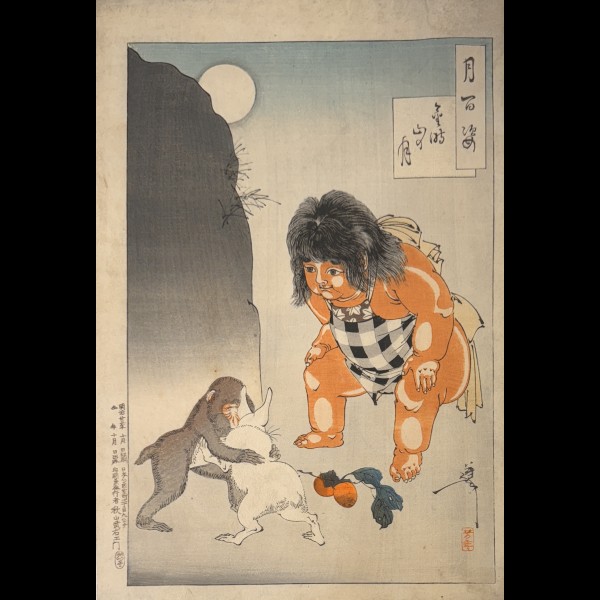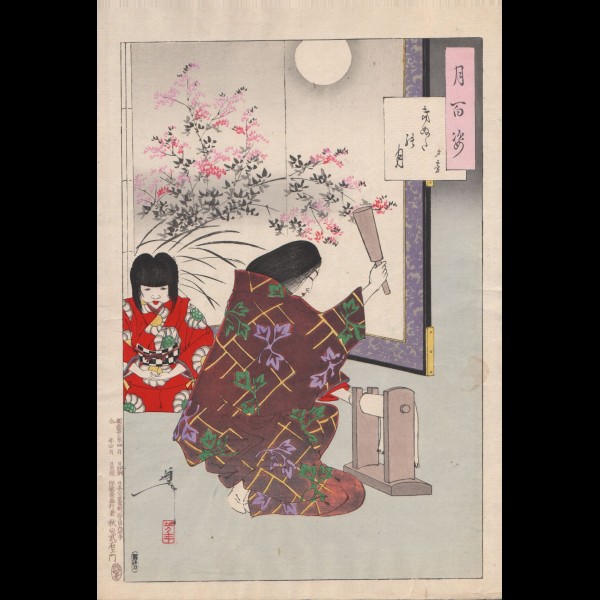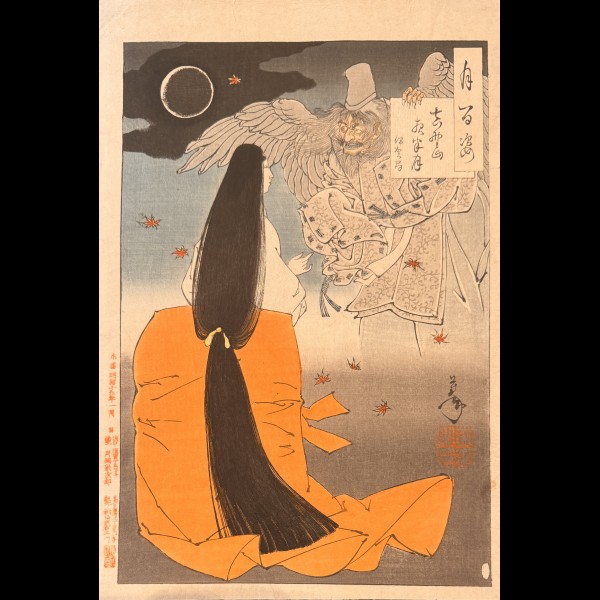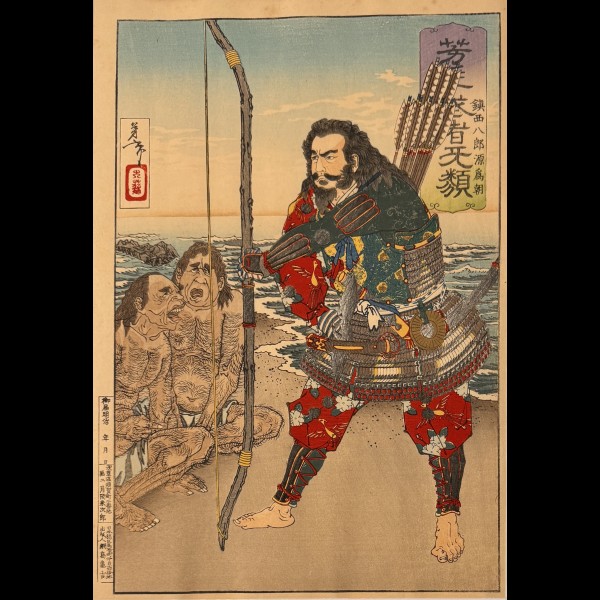YOSHITOSHI TSUKIOKA (1839 - 1892)
LA LUNE DE LA MONTAGNE DE KINTOKI
Kintoki-yama no tsukiThe boy with legendary strength, Kintoki, acting as referee in the sumo match between a monkey and a rabbit.N° 87 from the set: Tsuki No hyakushi (One Hundred Aspects of the Moon)1890ObanNishiki-eGood proof, tiny dirt on the outer borders, embossing in the white of one of the cartridges and in the rabbit's fur.Kintoki's father, a dissolute ronin, abandoned him at his birth on Mount Ashigara, not far from Fuji. He was taken in and raised by Yamauba, the woman-spirit who inhabited the mountains and embodied, in certain respects, the feminine side of primal savagery. She named him Kintarõ, the “Golden Boy”. He grew up among the mountain animals and the tengu, the birdmen who taught Yoshitsune martial arts. The child learned a lot from their contact, and quickly developed prodigious strength.One day when the warrior Yorimitsu, also called Raiko, was hunting in the vicinity of Mount Ashigara, an extraordinarily robust child, with skin the color of brick, suddenly appeared to him. He was uprooting a large tree to make a bridge that would allow the animals, his friends, to cross the river. Stunned, Yorimitsu convinced Yamauba to let him take the child to make him a hero.Renamed Kintoki, the young man became one of Raiko's four main lieutenants, proving his strength and bravery on many occasions. Yoshitoshi shows him battling monsters and demons in a multitude of prints. Perhaps the most famous example is the 1886 diptych from the Yoshitoshi manga series, where a superbly drawn spider-woman weaves her golden web around the sleeping Kintoki. The two characters in Kintoki's name mean "gold" and "time", but as with many Japanese names, the idea of a literal translation is somewhat futile. This change of name should above all be interpreted as marking the transition from boy to man.In ukiyo-e, Kintarõ is usually depicted in the company of mountain animals. We also see him as a wrestler, throwing a bear to the ground. Here he referees a parody of hand-to-hand combat between a monkey and a rabbit, two animals that we saw playing together in Sun Wukong's evocation. The color of his skin refers to his name - Kuniyoshi already liked to use shades of red to flatter the roundness of his body. Dressed as a boy, he displays the rolls of flesh which, in the minds of the Japanese and Chinese, denote a healthy child.His face beaming with happiness, Kintarõ watches his friends play. A branch of persimmon tree is placed between him and the animals: its persimmons perhaps allude to the fruits that the monkey stole from the immortals, or to the extraordinary powers of Kintaro. The fruit pigment has oxidized, taking on an interesting surface texture.The grain of the wood gives body to the rock, and the rabbit's coat is beautifully embossed.In : CENT ASPECTS DE LA LUNE, John STEVENSON, 2018, Editions Citadelles et MAZENODThe set “One Hundred Aspects of the Moon”, inspired by historical or legendary stories from China and Japan, is Yoshitoshi's most famo..
1,200.00 €
LUNE DU DRAP QU'ON BAT
Yugiri kinuta no tsuki #84From the sequel: Tsuki No hyakushi (The Hundred Aspects of the Moon)1890Publisher: Akiyama Buemon (Kokkeido)Seal: YoshitoshiEngraver: EnkatsuObannishiki-eGood proof, beautiful colors, a few folds in the upper border, some scattered foxing."In the nô play Kinuta (named after the roll of wood on which the sheet was beaten), a man from Kyüshü has been held in the capital for three years, awaiting a legal verdict. Nostalgic for his distant western island, he sends his servant Yúgiri to assure his wife that he will be back within the year. The wife is delighted by Yúgiri's visit, but longs for her husband. The two women hear then the sound of the sheet being beaten to wash or soften it. This is an obvious allusion to a poem from Tang China, in which a man hears despite the distance his wife beating the sheet while waiting for him. Yugiri brings a kinuta to console her mistress, who joins her in the nevertheless servile task of beating the sheet.When a new message arrives informing her that her husband will not return within a year, the woman goes crazy and dies of grief. Finally allowed to return home, the man learns of the death of his wife. His spirit appears to overwhelm him, but he manages to soothe it by chanting the Lotus Sutra - some sects believe that one can achieve salvation by repeating the name of this sutra alone.In the print, the wife beats the sheet, wrapped around her kinuta, with a wooden mallet.Obviously distant and absorbed in her work, she turns her back on Yugiri, who lowers her head. Instead of suggesting the comfort that the servant thought she brought, the image gives a feeling of overwhelm.The painted decoration of the screen, a bush of lespedezes in flower under the full moon, evokes autumn. The clear vertical lines on the left side reveal the structure of the panels. The background is otherwise totally abstract, reduced to a light gray wash which sinks into the darkness. If the servant's modern outfit is quite incongruous, the mistress wears an opulent dress worthy of a Noh costume. We glimpse a tabi, a tailor-made sock separating the big toe.The name Yügiri, which means "evening mist", is worn by many figures in Japanese culture, starting with the prince's son in Genji monogatari."In: ONE HUNDRED ASPECTS OF THE MOON, John STEVENSON, 2018, Editions Citadelles and MAZENODThe suite of “One Hundred Aspects of the Moon”, inspired by historical or legendary stories from China and Japan, is Yoshitoshi's most famous series, begun in 1885 and completed just before his death in 1892. Already at the time, each new print published was an event, the prints often selling out on the morning of their publication...
580.00 €
LUNE DE MINUIT AU MONT YOSHINO
Iga No TsuboneNo. 15 From the series: Tsuki No Hyakushi (The Hundred Aspects of the Moon)1889Seal: Yoshitoshi No InEngraver: EnkatsuJanuary 1886Obannishiki-eFine impression with embossing, particularly on the hair, beautiful colors, very light dusting on the outer edges. "The winged ghost that appears here is that of Sasaki no Kiyotaka, a high-ranking official at Emperor Go-Daigo's court in Kyoto. Dissatisfied with the purely nominal power granted to emperors, the ambitious Go-Daigo sought to exercise effective authority.In 1333, he overthrew the Hojo shogunate established in Kamakura and assumed political control of the country.Three years later, he found himself at odds with the Ashikaga clan. His advisors, aware of their military inferiority, agreed to retreat to give themselves time to raise troops. Among them was Kiyotaka's great rival: Kusunoki no Masashige. Kiyotaka, seeing that the emperor balked at such a renunciation, saw this as an opportunity to outmaneuver Masashige. In defiance of common sense, he declared that it was necessary on the contrary, fight. The emperor was easily convinced, and suffered a crushing defeat at the Battle of Minatogawa. The Ashikaga, now masters of the country, established themselves in Kyoto, and Go-Daigo fled to Yoshino, south of Nara, where he established a court competing with the new shogunate.As a reward for his ill-advised advice, Kiyotaka was forced to commit suicide. From then on, his spirit, refusing to take leave of the living, returned every night to float above the palace, overwhelming and terrorizing the exiled court. Seeing that no one dared to confront him, a valiant court lady named Iga no Tsubone resolved to seek him out, armed with a lantern full of fireflies. She managed to appease him, and he never appeared again.Iga no Tsubone was the wife of Kusunoki no Masashige's son, who was also driven to suicide after losing the battle he had fought against his will. From the Meiji era onward, the story of the loyal Masashige was remembered by the Japanese as a model of patriotism. As for his daughter-in-law, she proved her worth a second time when Go-Daigo was attacked by Ashikaga troops, by felling a tree to allow the empress to cross the ravine that separated her from the emperor.Here she is seen fearlessly confronting Kiyotaka's ghost. Her long hair falls to the ground, as was the fashion of the time. Engraving hair was a delicate exercise, as the thin wooden blades left protruding from the matrix to produce the lines wore down very quickly. The ghost's lips bear the blue color that ukiyo-e conventionally gave to corpses, and her eyes have a golden-yellow glow. Her clawed fingers cling to the title cartouche: Yoshitoshi, like other master printmakers, enjoyed playing with frames and borders. As for the moon, it shines through a diaphanous cloud, unless it's an eclipse—which would fit well with the fantastical theme of the print."In: ONE HUNDRED ASPECTS OF THE MOON, John STEVENSON, 2018, Ed..
680.00 €
MINAMOTO NO TAMETOMO
The great archer Chinzei Hachiro Minamoto Tametomo with two islanders from the island of Oniga-ShimaFrom the sequel: Yoshitoshi Musha buruiThe brave warriorsEdited by Maruya Tetsujirô1886Beautiful proof in very fresh colours, some scattered foxing mainly visible in the top margins, pinched fold in the upper border.Legend has it that Minamoto Tametomo (1139-1170) from a young age was an extremely skilled archer. Nearly seven feet tall and with a left arm four inches longer than his right, Tametomo used a seven and a half foot bow. Tametomo had a very wild and unpredictable character. At just fifteen years old, and without the emperor's permission, he conquered and took control of the island of Kyushu.Following the Hogen War (1156) in which he took part, Tametomo was sent into exile by the emperor on the island of Oshima (Izu province) where he gradually established himself as a local ruler.The print illustrates the moment when Tametomo discovered a nearby island, Oni-ga-shima, by following the flight of herons in a boat. The strange inhabitants were believed to be descendants of demons, but Tametomo subjugated them by impressing them with his strength.In 1170, the emperor sent the governor of Izu and his men to apprehend Tametomo. The hero sank the lead ship with a single arrow shot, but then decided to offer his bow to the Dragon King of the Sea and set his house on fire. By cutting his abdomen with his dagger, he would have initiated the tradition of honorable seppuku (ritual suicide)...
350.00 €





